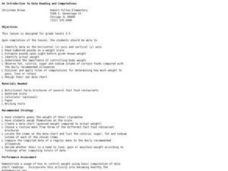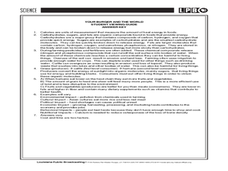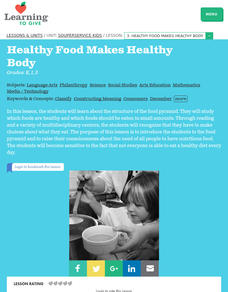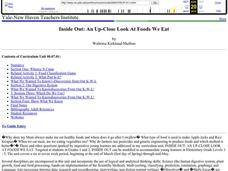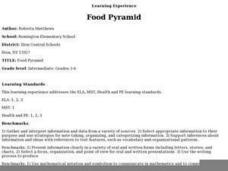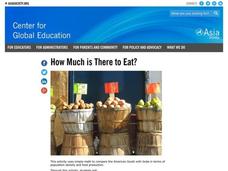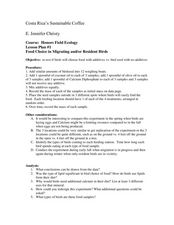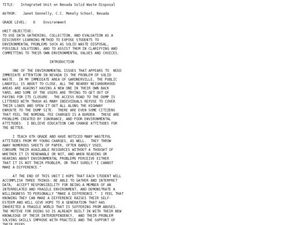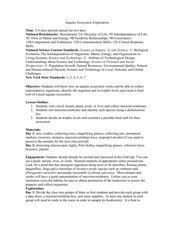Curated OER
An Introduction to Data Reading and Computations
Students discover data reading and computations. In this math lesson plan, students collect nutritional data about intakes of certain foods compared with daily recommended allowances. Students create their own data charts based on their...
Curated OER
Fast Food: You Can Choose!
Students research the nutritional value of fast food. They assess which fast foods are best and worst to eat. They organize their data into tables and graphs and explain their findings to other students.
Curated OER
Food Groups in our Lunch
Learners make a graph. In this food groups and graphing instructional activity, students pack a sack lunch and then work in groups to tally the number of foods from each food group that they have. Learners use the data collected to...
Curated OER
Investigating the Food Pyramid
Students examine how the food pyramid is an important nutritional tool. They classify foods and compare the number of servings per group that are necessary for maintaining good health by placing empty food containers in grocery bags.
Curated OER
Heathly Foods Makes Heathly Body
Young scholars examine and identify foods on the food pyramid. They catergorize food and place them on the correct level. They discover why they should eat foods in moderation.
Curated OER
First Place Foods
First graders identify healthy foods. In this nutrition lesson, 1st graders create a Venn diagram to compare and contrast healthy foods. Students place foods in the proper circle.
Curated OER
Inside Out: An Up-Close Look At Foods We Eat
Fourth graders identify the origins of meats and vegetables consumed by humans on a daily basis. They classify foods (meats, dairy products, grains...) and create a food pyramid.
Curated OER
Safe Food: It's Your Job Too!: Health
Young scholars get an overview of the importance of food safety and become familiar with common foodborne pathogens.
Curated OER
Food Pyramid - Daily Diet Diary
Students keep a daily diet diary and discuss the Food Pyramid. They investigate other geometric shapes as a way to display daily food guidelines. In groups, they design a menu for the Food Pyramid Restaurant.
Curated OER
Fast Food Fun
Students use technology to input, retrieve, organize, manipulate, evaluate, and communicate information to find calories and fat in a typical fast food meal. They decide which fast food restaurant you would like to visit and click on...
Curated OER
Food Web Mystery
Young scholars describe typical marine food webs, and explain why food is generally scarce in the deep-ocean environment. They discuss reasons that seamounts may support a higher density of biological organisms than would appear to be...
Curated OER
Food Webs
Students research what food is eaten by the following organisms: penguins leopard seals, krill, elephant seals, petrels, albatross, fur seals, squid, insects and grass. They make a food web using the data they have gathered.
Curated OER
A Coastal Arctic Food Web
High schoolers create a food web of the arctic ecosystem. In this biology lesson, students explain how global warming affects this ecosystem. They explain how losing a species affects the entire community.
Curated OER
Literary Response and Analysis
Eighth graders analyze the points of view and complete a literary analysis for The Cayby Theodore Taylor. In this literary analysis lesson, 8th graders read the novel and retell the story from Timothy's point of view, the cat's point of...
Curated OER
Can You Count on Cans?
How can a canned food drive be connected to math? It's as simple as counting and organizing the cans! Children demonstrate their ability to sort non-perishable foods into categories that include soup cans, vegetable cans, boxed items,...
Curated OER
How Much is There to Eat?
Students examine food production related to population density. For this interdisciplinary lesson, students gather data regarding food production in the American South and in India. Students follow the outlined steps to calculate the...
Curated OER
Costa Rica's Sustainable Coffee
Students experiment to see if birds prefer to eat bird seed with additives vs. no additives. In this experimental lesson students test to see if birds notice a difference between additive and no additive food.
Curated OER
Wow! You're Eating Geography
Young scholars examine patterns of food producing areas, and identify foods that are grown locally, in the U.S., and around the world. They map and graph the major food crops of their local area, the U.S., and other countries, and...
Curated OER
ESL: Nutrition/Label Reading
Assist your pupils in making healthy food choices with this lesson. First, have them bring in different kinds of food labels, and put a list of key words on the board (list is not included, but can be nutrition or health-related words)....
Curated OER
And You Thought Gasoline Was Expensive!
Students carry out a cost analysis. In this comparative math lesson, students compare the cost of equal measures of gasoline to mouthwash, house paint, fruit juice, white-out, and other liquids.
Curated OER
Recycling/Solid Waste Education with Shel Silverstein: "Sarah Cynthia Sylvia Stout"
Both poetry analysis and waste disposal are more engaging topics for young readers with a worksheet to accompany the Shel Silverstein poem 'Sarah Cynthia Sylvia Stout Would Not Take the Garbage Out" from Where the Sidewalk Ends. Not only...
Curated OER
Urban Ecosystems 2: Why are There Cities? A Historical Perspective
Second in a series of five lessons, this lesson encourages preteens to consider cities as urban ecosystems. First, they keep a food diary for a few days. They visit the Natrional Agricultural Statistics Service website for current data...
Curated OER
Integrated Unit on Nevada Solid Waste Disposal
Sixth graders examine how to gather and interpret data, accept responsibility for the environment, and demonstrate an interest in making a difference in this series of lessons.
Curated OER
Aquatic Ecosystem Exploration
Young scholars visit a local stream, pond, creek, or river and collect macroinvertebrates. They sort macroinvertebrates and identify each species using a dichotomous key. Students decide on trophic levels and construct a possible food...
